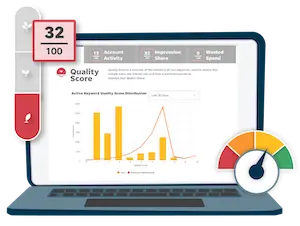Running a successful business inevitably brings negative online reviews. No matter how amazing your products or services, how well-trained your employees, or how excellent your customer service, there will always be situations when someone is dissatisfied with their interaction with your business or finds that your product or service doesn’t meet their needs and expectations.
But that doesn’t mean you have zero control over the situation! So how can you manage your online reviews to limit the negative impact on your business? In this article, we’ll discuss and analyze how online reviews can affect your click-through rates (CTR) and other key metrics, plus how they influence prospects and customers in sometimes surprising ways.
Contents
- Reviews and star ratings appear in search results and maps…
- …And almost everywhere else on the web
- Positive reviews are super engaging and drive clicks
- Negative reviews can lead to a loss of traffic
- Unhappy customers are more likely to leave reviews
- Positive reviews can capture zero-click searches
- Better online reviews = higher CTRs, traffic, and sales
- Fake reviews can hurt more than your reputation
- Positive reviews can boost PPC and social campaigns
9 reasons why reviews impact revenue, sales, and business reputation
Online reviews can impact your business’s online reputation, traffic, and sales. Here are a few ways that happens.
1. Reviews and star ratings appear in search results and maps…
When people search for businesses, products, or services on search engines or map pages, review sites not only appear in search results but also as featured snippets where review counts and star ratings are visible and highlighted even before users click on the result.
Google displays reviews and star ratings in both search results and local pack results for businesses listed on Google Business Profile (formerly Google My Business) or Google Maps.

Additionally, Google includes a “Reviews from the web” section in various business results and key phrases, aggregating reviews from relevant networks. In regular search results, when displaying a business profile from a review network, star ratings, and review counts are also presented.

On Bing local and maps results, review information and star ratings may be sourced directly from partner networks such as Facebook, OpenTable, TripAdvisor, or others depending on the search query.
DuckDuckGo, a private search engine, exclusively partners with Yelp to display business results, including reviews, for users.
🛑 Want to learn how to get more traffic and leads from search engines? Get the free guide >> PPC 101: Complete Guide to Google Ads
2. …And almost everywhere else on the web
Multiple websites collect online reviews, each serving different purposes and attracting distinct types of audiences and review readers. For instance, individuals planning a vacation often visit travel-specific sites to see experiences and photos shared by previous travelers. On the other hand, job seekers read reviews on job sites posted by current and former employees.
Here are some of the different types of review websites:
- Business directories, such as Google Business Profile (Google Maps), Trustpilot, and Yelp, list businesses and allow customers to rate them and leave reviews. Find out the top business listing sites here.
- Retail websites like Amazon, eBay, Walmart, and other ecommerce sites allow customers to review products they purchased and share their interactions with businesses.
- Travel review and booking networks like TripAdvisor, Expedia, Booking.com, Airbnb, and others enable travelers to review hotels, hosts, restaurants, and other travel-related services.
- Job networks and review sites, such as Glassdoor or Indeed, enable current and former employees, as well as job applicants, to review their employers, salaries, and benefits, share insights into the interview process, and office culture, and discuss their overall experiences.
- Social media networks like Facebook allow users to leave feedback, comments, and reviews on business pages.
- Online complaint sites like RipOff Report or Better Business Bureau (BBB) provide platforms for customers to express dissatisfaction with products or services they have purchased.
- Niche review websites like Capterra or G2 cater specifically to software buyers, and platforms such as Angi and DealerRater focus on local services and the car buying experience, respectively.

3. Positive reviews are engaging and drive clicks
Research from BrightLocal shows that businesses with positive 3 to 5-star reviews receive 25% more clicks from local pack results. Additionally, 82% of consumers read online reviews before making a purchase, spending an average of 14 minutes on review sites before making a decision. Positive reviews can also improve traffic to your site and boost revenue.
👀 Looking for more ways to drive people to your site? Free guide >> 25 Ways to Increase Traffic to Your Website
4. Negative reviews can lead to a decline in traffic
At the same time, negative reviews can be highly damaging. For example, a well-publicized lawsuit in Australia revealed that a plastic surgeon experienced a 23% drop in online traffic after a fake, damaging review was posted on Google Maps.
5. Unhappy customers are more likely to leave reviews
According to findings from Inc.com, when customers are unhappy, there’s a 91% chance they won’t do any business with that company again. Moreover, they are 10 to 15 times more likely to share their negative experience with others, often by posting bad reviews on online platforms about the product or service quality.

At the same time, only 1 out of 10 happy customers typically leave a positive review, indicating that many people may not remember positive experiences that long because when they are buying, they expect good service from businesses. Negative experiences tend to be more impactful and remembered longer.
6. Positive reviews can help with zero-click searches
Zero-click search is when users search for something on a search engine like Google but do not click any links in the results. Nearly 60% of searches result in no clicks. There are several reasons behind this phenomenon, such as people using search engines for spell checking or relying on widgets and highlighted information to quickly find answers to basic questions like “How old is Brad Pitt?” or “What day of the week is Christmas this year?”

Similarly, in business-related, local, product, and service searches, many users conduct research on companies and look for things like phone numbers, addresses, or feedback.
It results in zero-click when they look up business information including star ratings and reviews directly in the search snippets. That’s why the appearance of positive reviews can be as important as the company’s website itself in the decision-making process.
7. Better online reviews have a direct correlation with higher CTRs, traffic, and sales
Positive online reviews and good star ratings can drive increased traffic and sales to a website in two ways:
- Firstly, higher star ratings in search engine snippets enhance the chances of users clicking through to gather more information and conduct further research on the product or service, possibly leading to a purchase. At the same time, negative star ratings can deter users from clicking on a company website, and as proof, research by BrightLocal shows that a 25% improvement in click-through rates can be achieved with favorable reviews on Google results. As mentioned earlier, bad reviews can significantly impact click-through rate, just like with the plastic surgeon who saw a 23% drop in online traffic after a single bad review that appeared on top of Google results.
- Secondly, reviews influence traffic and sales by influencing Google’s prioritization of businesses with better local presence and positive reviews in Google Maps. Based on findings by FirstPageSage, achieving the top position in Google’s Local Pack results can lead to a 17% CTR.

You’re probably going to click on results for a business with reviews like this over one with a lower star rating or no reviews.
8. Fake reviews can impact online traffic and reputation
Another unfortunate thing that can impact online reputation and sales is fake reviews. Fake negative reviews present a big challenge for businesses and are enabled by the anonymity of online platforms. It is estimated that over 23% of online reviews are fake, and “bad actors” like competitors, scammers, or disgruntled employees can post false or defamatory information about a business.

This not only leads to decreased star ratings but can also cause a significant drop in traffic, directly impacting sales. Addressing this issue can be expensive, requiring businesses to allocate resources towards damage control, increase marketing efforts to recover lost revenue, and in some cases seek legal advice.
9. Positive reviews can enhance PPC and social campaigns
One effective strategy for promoting positive reviews and ratings to improve CTR for your ads is to integrate them into your PPC campaigns. For example, Google Ads allows you to add positive reviews as ad copy extensions. Google collaborates with supported review partners to integrate and highlight these reviews under advertisers’ search or shopping ads.

Star ratings from the stores are integrated and appear in the shopping ads.
Additionally, you can share positive reviews on social media platforms like Facebook, LinkedIn, X, and others. Promoting these reviews through sponsored campaigns targeted at your desired audience can further enhance your brand’s reputation and reach.
💰 Worried you’re wasting spend in Google Ads? Find out with a free, instant audit >> Google Ads Performance Grader
Positive online reviews are a must
Given the direct correlation between positive online reviews, click-through rates, and their impact on sales, businesses should prioritize monitoring and managing their online presence. This includes actively monitoring reviews and ratings, flagging and reporting fake or rule-violating reviews, and replying promptly to reviews to show customer service and commitment to future customers.
While some businesses are proactive in managing their online reputation, others may lack the knowledge and resources, especially when dealing with multiple review sites each with its own methods for managing business profiles, flagging, reporting, replying, and removing reviews.








